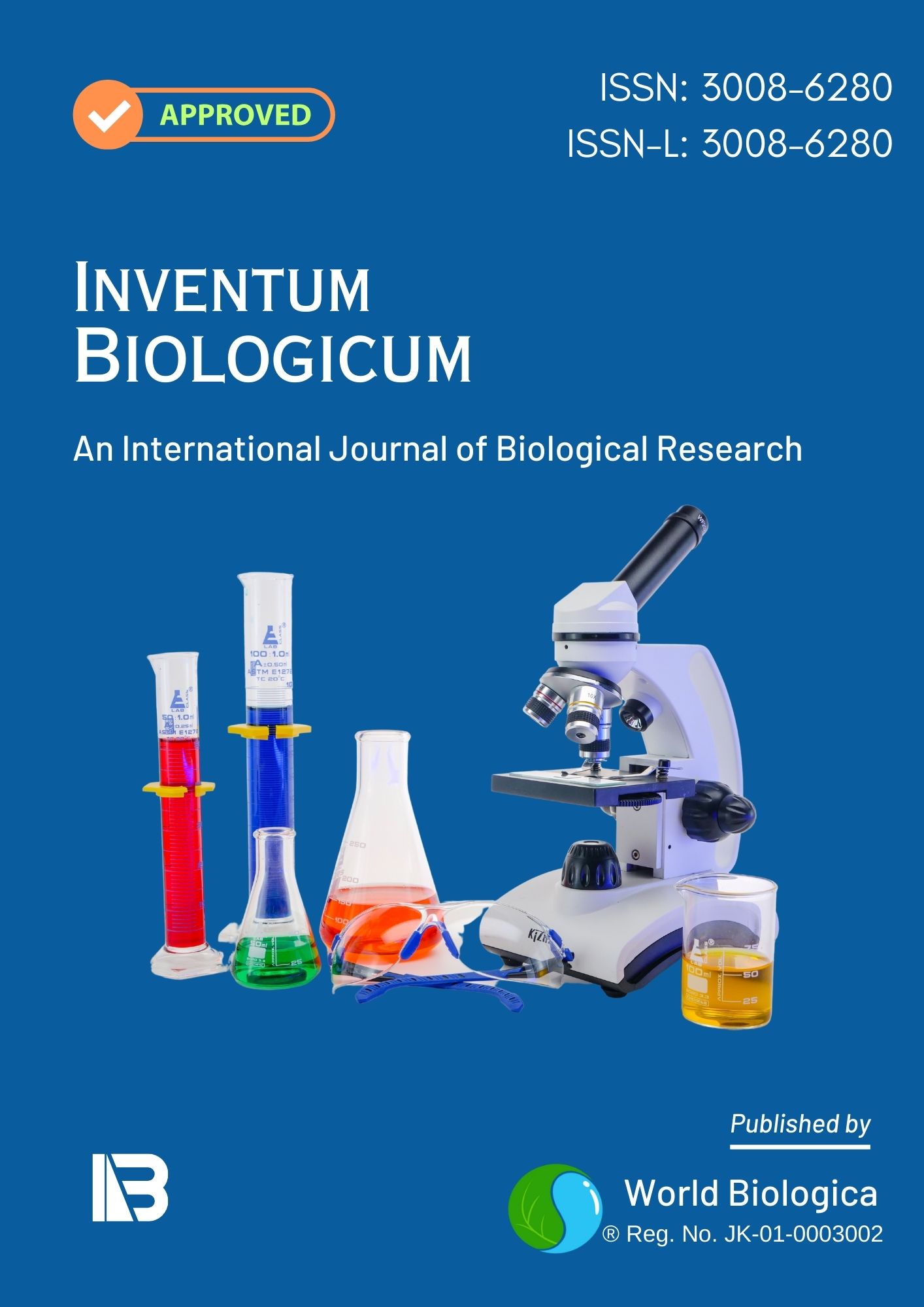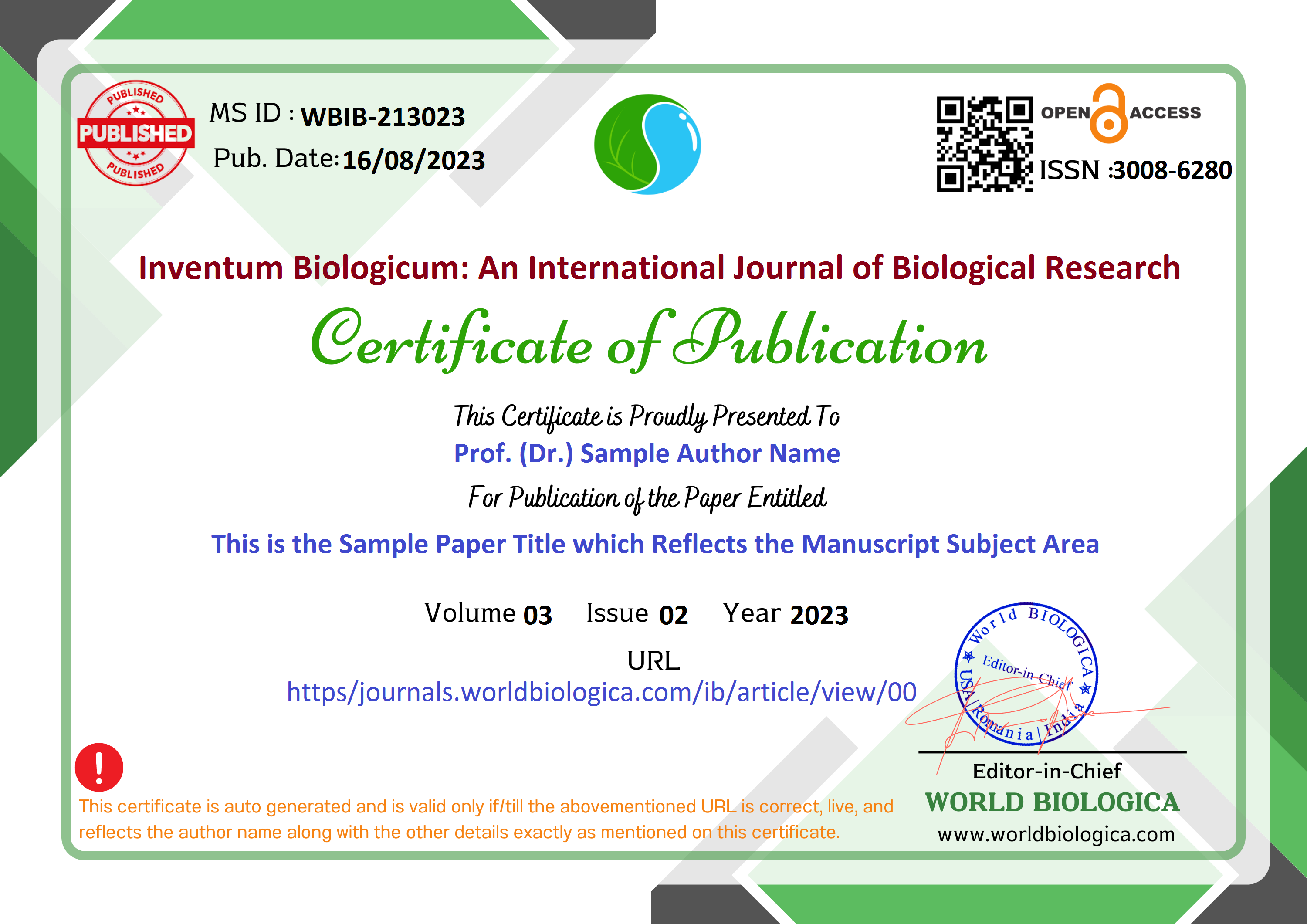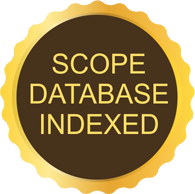Evaluation of Detrimental Missense SNPs of Human CXCL6 Gene by Combining Algorithms, Homology Modeling, and Molecular Docking
Keywords:
CXCL6, Cancer, Inflammation, SNPAbstract
Cancer is marked by uncontrolled cell proliferation, often driven by genetic mutations, including alterations in the CXCL6 gene on chromosome 4q21. CXCL6 is a crucial gene involved in immune responses and inflammation and has been implicated in promoting tumor growth and metastasis when overexpressed. This study utilized various bioinformatics tools to investigate the pathogenicity of missense nsSNPs within the CXCL6 gene, identified through the NCBI-SNP database and assessed their impact on protein stability and structural integrity. A total of 22 nsSNPs were identified as potentially harmful, with mutations such as L47M, C51R, L92M, L92V, P73S, and Q104K demonstrating significant structural alterations. Mutation clustering was performed using Mutation3D, and molecular docking studies were conducted with PyRx to evaluate ligand interactions with both wild-type and mutant protein forms. Five of the 25 ligands examined displayed promising docking scores, suggesting their potential as therapeutic inhibitors. Additionally, the Hope algorithm provided further insights into the structural consequences of these mutations. This study highlights the role of CXCL6 mutations in cancer progression and underscores the potential of CXCL6 expression as a predictive biomarker across various cancer types. These findings offer a foundation for exploring CXCL6 as a therapeutic target, contributing to personalized approaches in cancer treatment.
Downloads
References
AboElkhair, M.A., Hasan, M.E., Mousa, A., Moharam, I., Sultan, H., Malik, Y. & Sakr, M.A. (2021) In-silico evidence for enhancement of avian influenza virus H9N2 virulence by modulation of its hemagglutinin (HA) antigen function and stability during co-infection with infectious bronchitis virus in chickens. VirusDisease, 32, 548–558. DOI: https://doi.org/10.1007/s13337-021-00688-1, PubMed: https://www.ncbi.nlm.nih.gov/pubmed/34631979
Adasme, M.F., Linnemann, K.L., Bolz, S.N., Kaiser, F., Salentin, S., Haupt, V.J. & Schroeder, M. (2021) PLIP 2021: Expanding the scope of the protein–ligand interaction profiler to DNA and RNA. Nucleic Acids Research, 49, W530–W534. DOI: https://doi.org/10.1093/nar/gkab294, PubMed: https://www.ncbi.nlm.nih.gov/pubmed/33950214
Adhikari, S., Nath, P., Das, A., Datta, A., Baildya, N., Duttaroy, A.K. & Pathak, S. (2024) A review on metal complexes and its anti-cancer activities: Recent updates from in vivo studies. Biomedicine and Pharmacotherapy, 171, 116211. DOI: https://doi.org/10.1016/j.biopha.2024.116211, PubMed: https://www.ncbi.nlm.nih.gov/pubmed/38290253
Akhtar, A., Choudhry, S.N., Mateen, R.M. & Hussain, M. (2020) A comprehensive in silico analysis of deleterious SNPs of paraplegin protein associated with hereditary spastic paraplegia through mitochondrial dysfunction. BioScientific Review, 2, 1–14. DOI: https://doi.org/10.32350/BSR.0202.01
Aldinucci, D. & Colombatti, A. (2014) The inflammatory chemokine CCL5 and cancer progression. Mediators of Inflammation, 2014, 292376. DOI: https://doi.org/10.1155/2014/292376, PubMed: https://www.ncbi.nlm.nih.gov/pubmed/24523569
Aljindan, R.Y., Al-Subaie, A.M., Al-Ohali, A.I., Kumar D, T., Doss C, G.P. & Kamaraj, B. (2021) Investigation of nonsynonymous mutations in the spike protein of SARS-CoV-2 and its interaction with the ACE2 receptor by molecular docking and MM/GBSA approach. Computers in Biology and Medicine, 135, 104654. DOI: https://doi.org/10.1016/j.compbiomed.2021.104654, PubMed: https://www.ncbi.nlm.nih.gov/pubmed/34346317
An, X., Zhang, W., Rong, C. & Liu, S. (2023) Understanding Ramachandran plot for dipeptide: A density functional theory and I nformation-theoretic approach study. Journal of the Chinese Chemical Society, 70, 243–252. DOI: https://doi.org/10.1002/jccs.202200444
Arega, A.M., Dhal, A.K., Pattanaik, K.P., Nayak, S. & Mahapatra, R.K. (2024) An immunoinformatics-based study of Mycobacterium tuberculosis region of difference-2 uncharacterized protein (Rv1987) as a potential subunit vaccine candidate for preliminary ex vivo analysis. Applied Biochemistry and Biotechnology, 196, 2367–2395. DOI: https://doi.org/10.1007/s12010-023-04658-9, PubMed: https://www.ncbi.nlm.nih.gov/pubmed/37498378
Azmi, M.B., Khan, W., Azim, M.K., Nisar, M.I. & Jehan, F. (2023) Identification of potential therapeutic intervening targets by in-silico analysis of nsSNPs in preterm birth-related genes. PLOS ONE, 18, e0280305. DOI: https://doi.org/10.1371/journal.pone.0280305, PubMed: https://www.ncbi.nlm.nih.gov/pubmed/36881567
Banerjee, A., Kanwar, M., Santra, D. & Maiti, S. (2022) Global conserved RBD fraction of SARS-CoV-2 S-protein with T500S mutation in silico significantly blocks ACE2 and rejects viral spike. Translational Medicine Communications, 7, 2. DOI: https://doi.org/10.1186/s41231-022-00109-5, PubMed: https://www.ncbi.nlm.nih.gov/pubmed/35136839
Chen, C., Lin, C.J., Pei, Y.C., Ma, D., Liao, L., Li, S.Y., Fan, L., Di, G.H., Wu, S.Y., Liu, X.Y., Wang, Y.J., Hong, Q., Zhang, G.L., Xu, L.L., Li, B.B., Huang, W., Shi, J.X., Jiang, Y.Z., Hu, X. & Shao, Z.M. (2023) Comprehensive genomic profiling of breast cancers characterizes germline-somatic mutation interactions mediating therapeutic vulnerabilities. Cell Discovery, 9, 125. DOI: https://doi.org/10.1038/s41421-023-00614-3, PubMed: https://www.ncbi.nlm.nih.gov/pubmed/38114467
Chen, G., Seukep, A.J. & Guo, M. (2020) Recent advances in molecular docking for the research and discovery of potential marine drugs. Marine Drugs, 18, 545. DOI: https://doi.org/10.3390/md18110545, PubMed: https://www.ncbi.nlm.nih.gov/pubmed/33143025
Dakshitha, S., Priya Dharshini, B., Suresh, V. & Dilipan, E. (2024) Computational exploration of single-nucleotide polymorphisms in the human hRAS gene: Implications and insights. Cureus, 16, e53119. DOI: https://doi.org/10.7759/cureus.53119, PubMed: https://www.ncbi.nlm.nih.gov/pubmed/38420094
Do, H.T.T., Lee, C.H. & Cho, J. (2020) Chemokines and their receptors: Multifaceted roles in cancer progression and potential value as cancer prognostic markers. Cancers, 12, 287. DOI: https://doi.org/10.3390/cancers12020287, PubMed: https://www.ncbi.nlm.nih.gov/pubmed/31991604
Gerke, M.B., Jansen, C.S. & Bilen, M.A. (2024) Circulating tumor DNA in genitourinary cancers: Detection, prognostics, and therapeutic implications. Cancers, 16. DOI: https://doi.org/10.3390/cancers16122280, PubMed: https://www.ncbi.nlm.nih.gov/pubmed/38927984
Ghorbanpour, M., Shayanfar, A. & Soltani, B. (2024) Copper pyrazole complexes as potential anticancer agents: Evaluation of cytotoxic response against cancer cells and their mechanistic action at the molecular level. Coordination Chemistry Reviews, 498, 215459. DOI: https://doi.org/10.1016/j.ccr.2023.215459
Goswami, V., Patel, D., Rohit, S., Chaube, U. & Patel, B. (2024) Homology modeling, binding site identification, molecular docking and molecular dynamics simulation study of emerging and promising drug target of Wnt signaling–Human Porcupine enzyme. Results in Chemistry, 7, 101482. DOI: https://doi.org/10.1016/j.rechem.2024.101482
Harihar, B., Saravanan, K.M., Gromiha, M.M. & Selvaraj, S. (2024) Importance of inter-residue contacts for understanding protein folding and unfolding rates, remote homology, and drug design. Molecular Biotechnology, 1–23. DOI: https://doi.org/10.1007/s12033-024-01119-4, PubMed: https://www.ncbi.nlm.nih.gov/pubmed/38498284
Hoffman, J.I., Vendrami, D.L.J., Hench, K., Chen, R.S., Stoffel, M.A., Kardos, M., Amos, W., Kalinowski, J., Rickert, D., Köhrer, K., Wachtmeister, T., Goebel, M.E., Bonin, C.A., Gulland, F.M.D. & Dasmahapatra, K.K. (2024) Genomic and fitness consequences of a near-extinction event in the northern elephant seal. Nature Ecology and Evolution. DOI: https://doi.org/10.1038/s41559-024-02533-2, PubMed: https://www.ncbi.nlm.nih.gov/pubmed/39333394
Huang, P.P., Wu, T.T., Tuo, M.Q., Ge, J., Huang, P., Wang, W.Q., Yang, J.P., Pan, H.B. & Lu, J.F. (2024) Supramolecular complexes of Co (II). Journal of Molecular Structure, 1307, 138061. DOI: https://doi.org/10.1016/j.molstruc.2024.138061
Kantelis, K.F., Asteriou, V., Papadimitriou-Tsantarliotou, A., Petrou, A., Angelis, L., Nicopolitidis, P., Papadimitriou, G. & Vizirianakis, I.S. (2022) Graph theory-based simulation tools for protein structure networks. Simulation Modelling Practice and Theory, 121, 102640. DOI: https://doi.org/10.1016/j.simpat.2022.102640
Khamlich, J. et al. (2023) In silico analysis predicting the structural and functional effects of high-risk nsSNPs in the human GCK gene associated with gestational diabetes. Physical Chemistry Research, 11, 653–673.
Komolafe, K., Pacurari, M. & Chemokines, C.X.C. (2022) CXC Chemokines in the Pathogenesis of Pulmonary Disease and Pharmacological Relevance. In: International Journal of Inflammation, 2022, 4558159. DOI: https://doi.org/10.1155/2022/4558159, PubMed: https://www.ncbi.nlm.nih.gov/pubmed/36164329
Kumar, N. et al. (2024) Bioinformatics tools to study homology modeling. Computational Biology in Drug Discovery and Repurposing, 75.
Kurma, K. & Alix-Panabières, C. (2023) Mechanobiology and survival strategies of circulating tumor cells: A process towards the invasive and metastatic phenotype. Frontiers in Cell and Developmental Biology, 11, 1188499. DOI: https://doi.org/10.3389/fcell.2023.1188499, PubMed: https://www.ncbi.nlm.nih.gov/pubmed/37215087
Laskar, F.S., Bappy, M.N.I., Hossain, M.S., Alam, Z., Afrin, D., Saha, S. & Ali Zinnah, K.M. (2023) An in silico Approach towards Finding the Cancer-Causing Mutations in Human MET Gene. International Journal of Genomics, 2023, 9705159. DOI: https://doi.org/10.1155/2023/9705159, PubMed: https://www.ncbi.nlm.nih.gov/pubmed/37200850
Mohd Abas, M.D., Mohd Asri, M.F., Yusafawi, N.A.S., Rosman, N.A.Z., Baharudin, N.A.Z., Taher, M., Susanti, D. & Khotib, J. (2024) Advancements of gene therapy in cancer treatment: A comprehensive review. Pathology, Research and Practice, 261, 155509. DOI: https://doi.org/10.1016/j.prp.2024.155509, PubMed: https://www.ncbi.nlm.nih.gov/pubmed/39121791
Mohkam, M., Golkar, N., Nabavizadeh, S.H., Esmaeilzadeh, H., Berenjian, A., Ghahramani, Z., Golami, A. & Alyasin, S. (2022) In silico evaluation of nonsynonymous SNPs in human ADAM33: The most common form of genetic association to asthma susceptibility. Computational and Mathematical Methods in Medicine, 2022, 1089722. DOI: https://doi.org/10.1155/2022/1089722, PubMed: https://www.ncbi.nlm.nih.gov/pubmed/36411793
Ni, B., Wang, H., Khalaf, H.K.S., Blay, V. & Houston, D.R. (2024) AutoDock-SS: AutoDock for multiconformational ligand-based virtual screening. Journal of Chemical Information and Modeling, 64, 3779–3789. DOI: https://doi.org/10.1021/acs.jcim.4c00136, PubMed: https://www.ncbi.nlm.nih.gov/pubmed/38624083
Nussinov, R., Jang, H., Tsai, C.J. & Cheng, F. (2019) Review: Precision medicine and driver mutations: Computational methods, functional assays and conformational principles for interpreting cancer drivers. PLOS Computational Biology, 15, e1006658. DOI: https://doi.org/10.1371/journal.pcbi.1006658, PubMed: https://www.ncbi.nlm.nih.gov/pubmed/30921324
Panchal, N.K., Mohanty, S. & Prince, S.E. (2024) Computational insights into NIMA-related kinase 6: unraveling mutational effects on structure and function. Molecular and Cellular Biochemistry, 479, 2989–3009. DOI: https://doi.org/10.1007/s11010-023-04910-0, PubMed: https://www.ncbi.nlm.nih.gov/pubmed/38117419
Rehman, H.M. et al. (2024) A comprehensive in silico study of the NDB-IL-24 fusion protein for tumor targeting: A promising anticancer therapeutic candidate. Journal of Biological Regulators and Homeostatic Agents, 38, 3449–3461.
Rozario, L.T., Sharker, T. & Nila, T.A. (2021) In silico analysis of deleterious SNPs of human MTUS1 gene and their impacts on subsequent protein structure and function. PLOS ONE, 16, e0252932. DOI: https://doi.org/10.1371/journal.pone.0252932, PubMed: https://www.ncbi.nlm.nih.gov/pubmed/34125870
Sameer, A.S. & Nissar, S. (2021) Toll‐like receptors (TLRs): Structure, functions, signaling, and role of their polymorphisms in colorectal cancer susceptibility. BioMed Research International, 2021, 1157023. DOI: https://doi.org/10.1155/2021/1157023, PubMed: https://www.ncbi.nlm.nih.gov/pubmed/34552981
Shah, B., Modi, P. & Sagar, S.R. (2020) In silico studies on therapeutic agents for COVID-19: Drug repurposing approach. Life Sciences, 252, 117652. DOI: https://doi.org/10.1016/j.lfs.2020.117652, PubMed: https://www.ncbi.nlm.nih.gov/pubmed/32278693
Sultana, T., Mou, S.I., Chatterjee, D., Faruk, M.O. & Hosen, M.I. (2024) Computational exploration of SLC14A1 genetic variants through structure modeling, protein-ligand docking, and molecular dynamics simulation. Biochemistry and Biophysics Reports, 38, 101703. DOI: https://doi.org/10.1016/j.bbrep.2024.101703, PubMed: https://www.ncbi.nlm.nih.gov/pubmed/38596408
Sung, H., Ferlay, J., Siegel, R.L., Laversanne, M., Soerjomataram, I., Jemal, A. & Bray, F. (2021) Global cancer statistics 2020: GLOBOCAN estimates of incidence and mortality worldwide for 36 cancers in 185 countries. CA: A Cancer Journal for Clinicians, 71, 209–249. DOI: https://doi.org/10.3322/caac.21660, PubMed: https://www.ncbi.nlm.nih.gov/pubmed/33538338
Tatarkova, E.A., Tuguz, A.R., Shumilov, D.S., Muzhenya, D.V., Rudenko, K.A. & Smolkov, I.V. (2022) SNP genes of immune response mediators and predisposition to development of socially significant diseases. Medical Immunology (Russia), 24, 751–764. DOI: https://doi.org/10.15789/1563-0625-SGO-2380
Waheed, S., Ramzan, K., Ahmad, S., Khan, M.S., Wajid, M., Ullah, H., Umar, A., Iqbal, R., Ullah, R. & Bari, A. (2024) Identification and in-silico study of non-synonymous functional SNPs in the human SCN9A gene. PLOS ONE, 19, e0297367. DOI: https://doi.org/10.1371/journal.pone.0297367, PubMed: https://www.ncbi.nlm.nih.gov/pubmed/38394191
Wuyts, A., Struyf, S., Gijsbers, K., Schutyser, E., Put, W., Conings, R., Lenaerts, J.P., Geboes, K., Opdenakker, G., Menten, P., Proost, P. & Van Damme, J. (2003) The CXC chemokine GCP-2/CXCL6 is predominantly induced in mesenchymal cells by interleukin-1beta and is down-regulated by interferon-gamma: Comparison with interleukin-8/CXCL8. Laboratory Investigation; a Journal of Technical Methods and Pathology, 83, 23–34. DOI: https://doi.org/10.1097/01.lab.0000048719.53282.00, PubMed: https://www.ncbi.nlm.nih.gov/pubmed/12533683
Yang, H.D. & Nam, S.W. (2020) Pathogenic diversity of RNA variants and RNA variation-associated factors in cancer development. Experimental and Molecular Medicine, 52, 582–593. DOI: https://doi.org/10.1038/s12276-020-0429-6, PubMed: https://www.ncbi.nlm.nih.gov/pubmed/32346127
Yasmin, T. (2022) In silico comprehensive analysis of coding and non-coding SNPs in human mTOR protein. PLOS ONE, 17, e0270919. DOI: https://doi.org/10.1371/journal.pone.0270919, PubMed: https://www.ncbi.nlm.nih.gov/pubmed/35788771
Zhang, N. & Li, Y. (2023) Receptor tyrosine kinases: Biological functions and anticancer targeted therapy. MedicoComm (2020), 4, e446. DOI: https://doi.org/10.1002/mco2.446, PubMed: https://www.ncbi.nlm.nih.gov/pubmed/38077251
Downloads
-
Download PDF
 Abstract Views: 188,
Abstract Views: 188,  Download PDF: 101
Download PDF: 101
Published
How to Cite
Issue
Section
License
Copyright (c) 2024 Inventum Biologicum: An International Journal of Biological Research

This work is licensed under a Creative Commons Attribution-NonCommercial-NoDerivatives 4.0 International License.


















